One of my favourite historic aircraft in Australia is the Imperial German Air Service Albatros D.Va (serial number D.5390/17, manufactured around August/September 1917), a World War One scout aircraft displayed at the Australian War Memorial ANZAC Hall, Over the Front: The Great War in the Air exhibition in Canberra. The predecessor of this aircraft was the Albatros D.III which entered German service in December 1916 and was able to help maintain German air superiority up until early 1917. By mid-1917 Allied fighters such as the British Royal Aircraft Factory S.E.5 and French Spad VII regained control of the skies though and a new scout aircraft was once again required (aviation technology was moving rapidly in these early air combat days).

The Albatros D.V which replaced the Albatros D.III, first flew in April 1917 and was fitted with a new and more powerful Mercedes D.IIIa 180hp engine which increased the overall speed of the aircraft. 900 D.V models were produced but they had an issue with upper wing weakness and failure which obviously caused much concern with German pilots as it was said to be worse than the D.III (the D.III had a similar issue with the lower wing failing in dives. Note: the proposed D.IV variant never went into production)! This aircraft was a capable fighter but obviously not 100% suitable and immediate improvement was required.
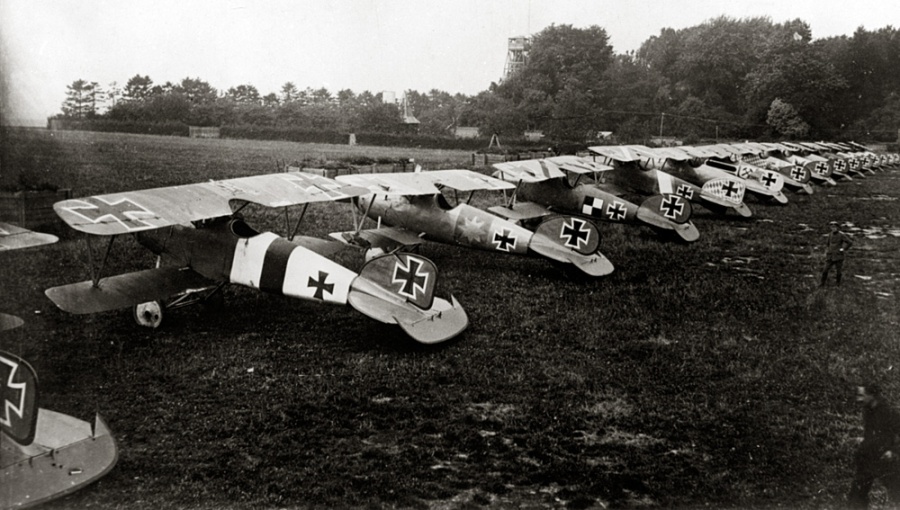
From August 1917 to mid 1918 approximately 1,600 improved Albatros D.Va models were then produced. Delivery of this model began in October 1917 and featured strengthened wings but this added weight reduced the performance gained from the more powerful 180hp Mercedes engine original fitted in the D.V model. Ultimately, despite structural improvements, even the new models still had issues with lower wing failures in a dive, so a small auxiliary strut was added to all D.V/D.Va outer wing struts to help improve the situation (which was not overly successful).

By early 1918 the type was obsolete and outclassed by new Allied fighters but the D.Va variant flew on until the end of the war in November 1918 (although by April 1918 it was being replaced by the superior Fokker D.VII scout). Despite its issues many of the top German air aces of World War One scored many of their air to air victories flying an Albatros scout aircraft (Manfred von Richthofen – see below, scored three-quarters of his victories in Albatros scouts).
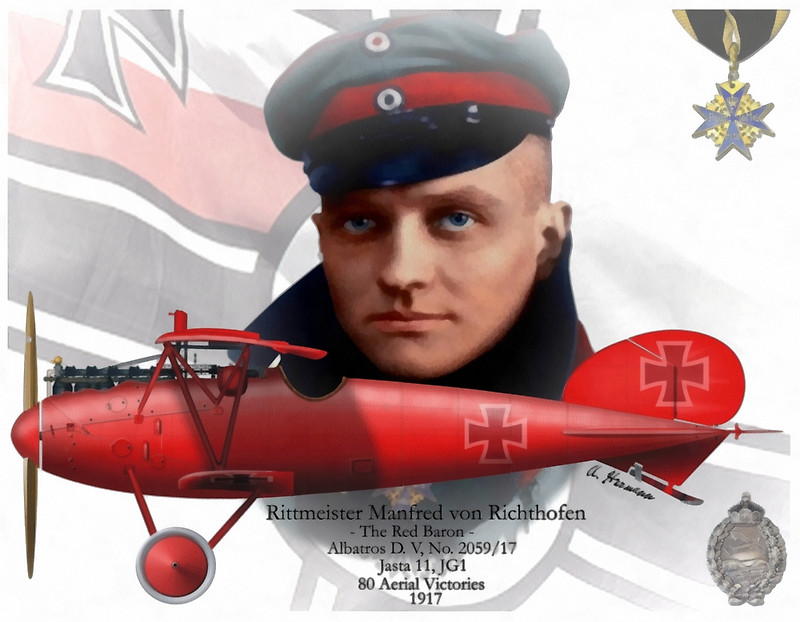
AWM Albatros D.Va
What is so special about the Australian War Memorial Albatros D.Va? Well firstly it is one of only two original aircraft of its type left. The other surviving example is in the Smithsonian National Air and Space Museum in Washington DC. I have been lucky enough to see both aircraft in person on a number of occasions (both museums are a personal favourite to visit).

The Australian War Memorial Albatros D.Va (serial number D.5390/17) features much of its original printed five-colour lozenge linen fabric and painted camouflage pattern of mauve and green on the wings and tail. It was armed with 2 x two MG08/15 7.92mm machine guns that were synchronized to fire through the propeller arc. Although fitted with a Mercedes D.IIIa 180hp engine it is not the original one installed in the aircraft when manufactured in 1917, that is curiously fitted in a Pflaz D.XII at the museum (see my next post for more on this aircraft)!

The history on how the Australian War Memorial example came to be on display at the museum is quite interesting too. On December 17th, 1917 six Albatros D.Va scouts believed to be from Royal Prussian Jasta 29 based at Bellincamp attacked an Australian Flying Corps (AFC) No. 3 Squadron Royal Aircraft Factory R.E.8 two-seat reconnaissance aircraft (serial number A3618) that was flown by pilot Lieutenant J. L. M. Sandy with observer Sergeant H. F. Hughes. The AFC aircraft defended itself for a number of minutes and managed to shoot down this Albatros D.Va, which was flown by Leutnant Rudolf Clausz (he was wounded and crash landed).
Two other AFC No. 3 Squadron R.E.8 aircraft joined the dog fight and after a further 10 minutes of combat, the remaining German aircraft broke off and left the engagement. Unfortunately Sandy and Hughes had both been killed by a single bullet during the ensuing engagement, strangely the R.E.8 kept flying in a straight line and eventually crashed some 80km away after running out of fuel!

Clausz crash landed in the lines of the 21st Battalion, 2nd Australian Division AIF and was taken prisoner. Under heavy artillery fire the aircraft was recovered by personnel of AFC No. 3 Squadron. The Albatros mainly only had bullet damage to its fuel tank, so it was repaired and then flown to the United Kingdom where it was test flown by the Royal Flying Corps Aeroplane Experimental Station.
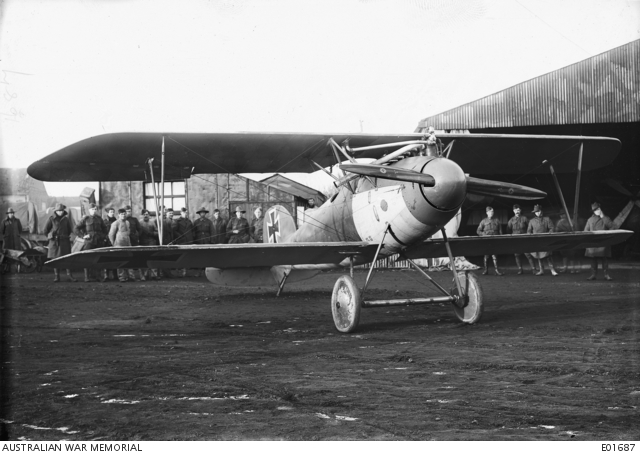
Left to right: Air Mechanic Second Class (2nd AM) Maher; Sergeant (Sgt) Nicholson; 2nd AM Lickle; 1st AM Kennedy; Sgt Sevald; 2nd AM Baird; 2nd AM McDermott; 2nd AM Turnbull; Sgt Ennis; 2nd AM Worseley; 2nd AM Hurst; Lieutenant Neilson; Corporal (Cpl) Holderson; 2nd AM Knox; Cpl Field; Cpl Green; Cpl Holford; Sgt P. J. Pearce; 1st AM Lovegrove (Photo Source: Australian War Memorial)

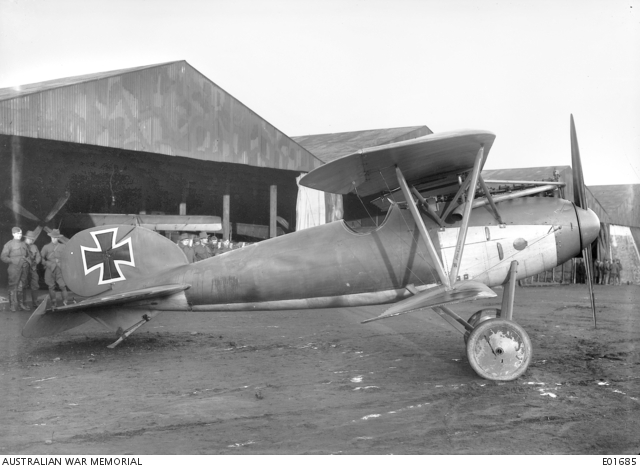
Australia lodged a claim for the aircraft as a war trophy which was approved. It was displayed at Australia House in London in early 1918 and was then dismantled and shipped to Australia in May 1918.

During 1920 the Albatros D.Va was exhibited in Adelaide, Melbourne and Sydney. From 1941 to the early 1960’s it was displayed at the war memorial before being stored at Duntroon military college. Reconstruction and restoration began in the mid 1960’s. With the aim to keep the aircraft in its original condition, this was a major job and was not fully completed until 2008 when the aircraft was returned to display at the war memorial. At almost 100 years old it looks pretty good!
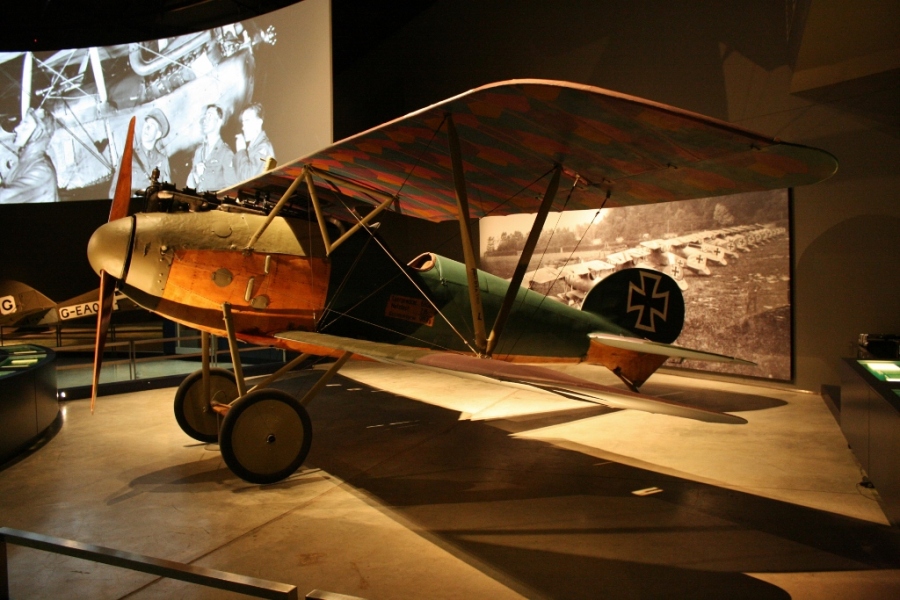
NASM Albatros D.Va
The other surviving D.Va on display at the Smithsonian National Air and Space Museum (NASM) in Washington DC (serial number D.7161/17) served with the Imperial German Air Service Jasta 46 (formed at Graudenz on December 17th, 1917) before being captured in April/May 1918. It is one of the last batch of 550 aircraft produced that were at the frontline by April 1918 and also features the distinctive lozenge camouflage scheme on its wings.

The aircraft is understood to have been a gift from the French government and arrived in the United States as a war trophy in 1919. It was originally presented to the De Young Memorial Museum in San Francisco on July 13th, 1919 and then sold for just $500 into private hands again in 1947. A Smithsonian curator persuaded the new owner to donate it to the Smithsonian collection (if packing and shipping costs were covered), which finally funded its transport to storage in Illinois in 1949 and then to Washington DC in 1952, where it remained in storage again until restoration commenced in 1977.
The operating squadron was identified during a restoration of the NASM aircraft from 1977 to 1979 when the original layer of paint was uncovered and showed green and yellow stripes on the tail which were the markings for Jasta 46. It was also discovered that it is constructed from components of different Albatros D.Va aircraft. The workmanship of the wings are of a different quality indicating they were manufactured in separate locations and not at the same time, also the national insignia painted on the aircraft differ with both straight crosses on the wings as well as the earlier Iron Cross on the fuselage. These variances perhaps indicate wartime repairs to the aircraft (the aircraft also has damage from a bullet that passed through the right machine gun mount, through the emergency fuel tank and into the right magneto).
Other Signficant AWM World War One Artifacts
Within the Australian War Memorial ANZAC Hall are some other impressive artifacts from World War One, including those linked to Manfred von Richthofen the “Red Baron”, the leading World War One German air ace with 80 air to air victories. He was officially shot down by Canadian RFC pilot Arthur “Roy” Brown over the Western Front on April 21st, 1918 but later research indicates it is highly likely that ground troops from a battery of Australian Field Artillery firing machine guns and rifles at him were actually responsible for his death (only one bullet was found in his body. It had penetrated his right armpit and then through his heart, indicating the shot came from below, not behind or above). Richthofen was only 25 years old. Given he came down near Australian lines, AFC Number 3 Squadron being the closest, assumed responsibility for his remains.
Richthofen’s Fokker Dr.I Driedecker triplane apparently landed mostly intact, but before it could be secured souvenir hunters had pretty much pulled it apart! Some parts of the aircraft and some of his personal effects are today held by the Australian War Memorial including his fur-lined flying boots and the control column and compass from the triplane. They are displayed next to the Albatros D.Va in ANZAC Hall today.

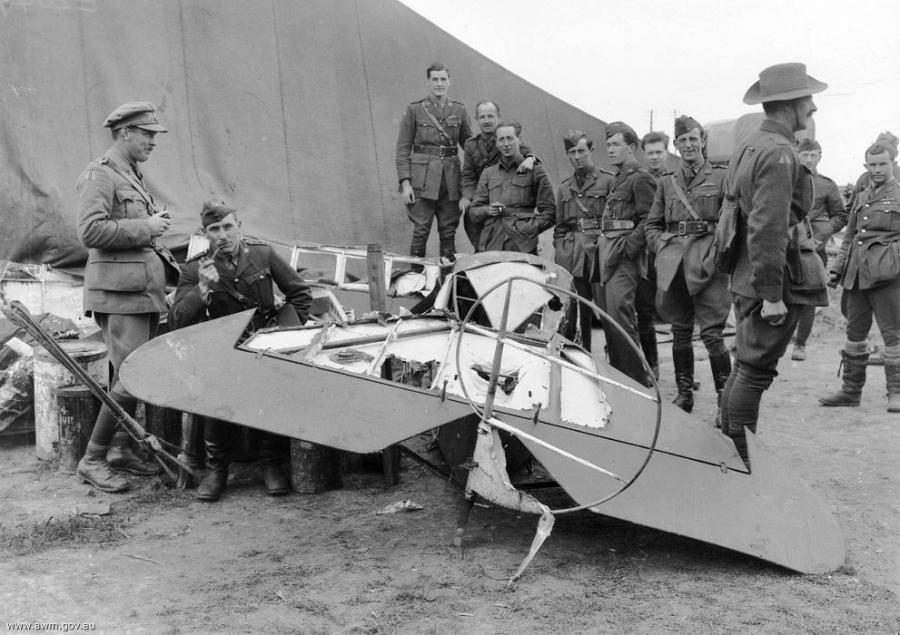
Mephisto, the last Imperial German Army A7V Sturmpanzerwagen World War One tank is also on display within ANZAC Hall. Normally Mephisto is part of the Queensland Museum collection where it has been since 1919 but currently it is on loan to the Australian War Memorial from June 2015 to April 2017, for their World War One Centennial exhibition.

Another significant piece of German aviation history within the collection is a 1918 Pfalz D.XII scout. More on this aircraft in my next post.
References:
Australian War Memorial – Albatros D.Va Scout Aircraft
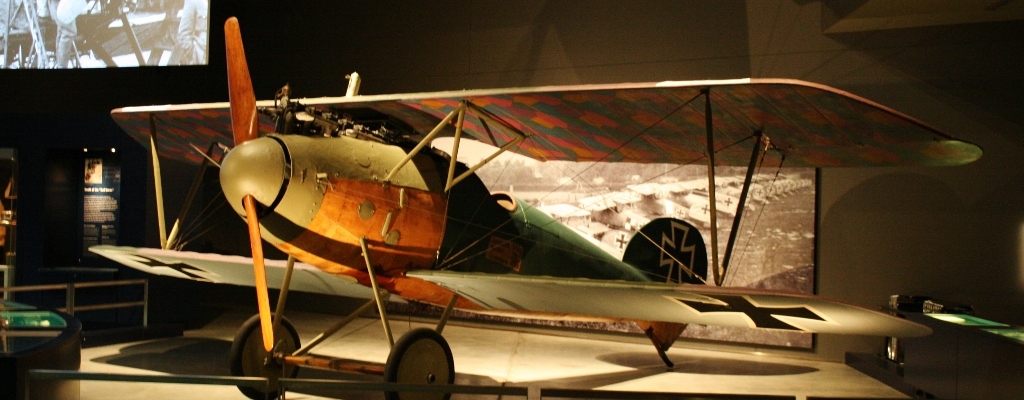
It’s great to see these fabulous aircraft on display. It’s remarkable too, even after much restoration work, that they are in great condition.
LikeLiked by 1 person
Yes very much so and we are lucky to still have them around given the wood and canvas type construction!
LikeLiked by 1 person
Definitely!
LikeLike
The Canberra Albatros D.Va assisted with the design of The Vintage Aviator’s reproduction aircraft
http://thevintageaviator.co.nz/projects/aircraft/albatros-dva/creating-new-albatros
I haven’t seen it myself (yet), as the WW1 galleries were being refurbished when I visited.
Thanks for the report!
LikeLike
They have done a great job on those reproductions. I have seen quite a few of the various models fly in NZ
LikeLike
Timing the guns to fire through the propeller seems a nifty idea, so I’m wondering why it didn’t catch on with the Allied air forces.
LikeLike
It did, from the middle of the war onwards.
LikeLiked by 1 person
Thanks Errol. Yes the Allies just liked to keep the moveable gun above the wing to give more options in a fight
LikeLiked by 1 person
I read somewhere that even before the war someone, can’t remember who or which side had invented an interrupter gear.
LikeLiked by 2 people
Hi Paul, I believe France and Germany were experimenting with the concept prior to the war but Germany was the first to “perfect” it during combat (with some extreme trial and error no doubt!)
LikeLike
Thank you, gents.
LikeLiked by 1 person